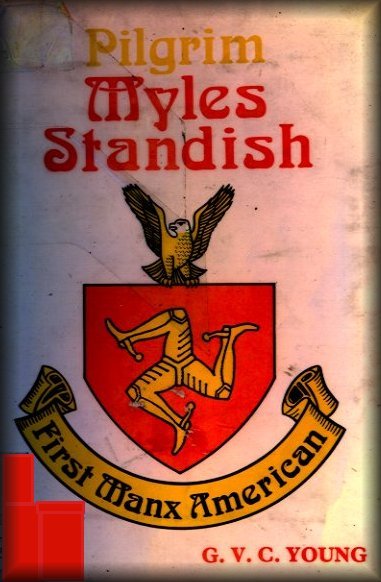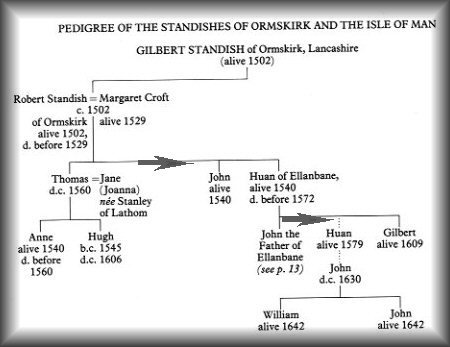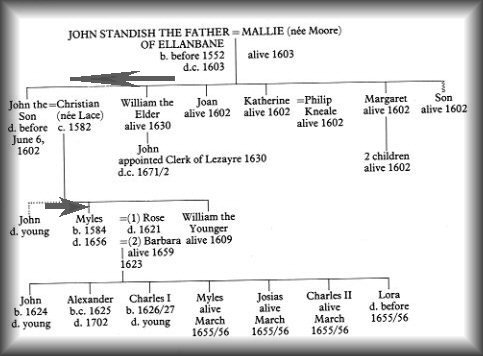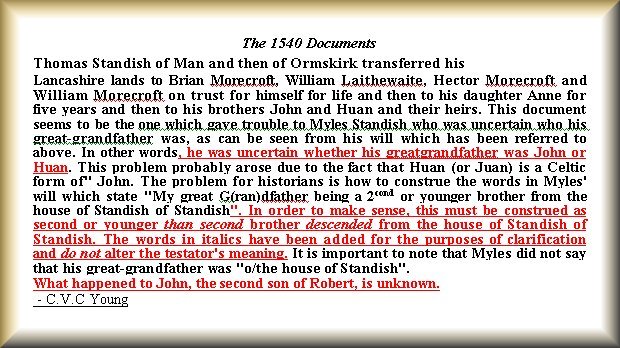

MYLES STANDISH
Myles
Standish was Born in The Isle of Man
Myles Standish's Will
The
evidence relating to the Manx origins of Myles Standish is based on
documentary and circumstantial evidence and is corroborated by oral tradition
in the Isle of Man.
The
starting point for the investigation is his will, dated the 7th March 1655
(1656 according to our present Calendar) and exhibited before the court
at Plymouth, Massachusetts, on the 4th May 1657.* The relevant part of the will is
as follows:
"I
give unto my son & heire apparent Allexander Standish all my lands as
heire apparent by lawful Descent in Ormistick Borsconge Wright-ington
Maudsley Newburrow Craston and the He of man and given to mee as right heire by
lawfull Descent but Surruptuously Detained from mee
my great G(ran)dfather being a 2cond or younger brother from the house
of Standish of Standish."
It
would seem likely that the details of the properties in Lancashire given
in the will have been taken from a trust deed executed by Thomas Standish
on the 7th July 1540 {see entry 7 in Appendix (1) by which lands in
Lancashire corresponding to those mentioned in Myles Standish's will were
transferred to trustees for the benefit of his daughter and brothers.
The
Four main Branches of the Standish Family
The
senior branch of the Standish family had its seat at Standish Hall in
the parish of Standish, which is situated not far from Wigan in Lancashire.
The
second branch of the family were the Standishes who had their seat at
Duxbury which is near Chorley, also in Lancashire. Their family church
was in Chorley.
A
sub-branch of the Standishes of Standish was situated at Ormskirk in Lancashire,
which lies South-West of Standish Hall. The Manx branch of the
Standish family was descended from the Ormskirk branch of the family.
It
seems abundantly evident that the lands claimed by Myles Standish belonged
to the Ormskirk/Manx branch of the Standish family and not to either
the Standishes of Standish or to the Standishes of Duxbury. This point
has been very fully researched by the late Canon Porteus, who supports
this view, and the writer of this Monograph has arrived at the same conclusion.
According to Porteus, the generally accepted view in America is that Myles Standish was born in 1584 although a minority view is of the opinion that he was born in 1586/7. The Encyclopaedia Britannica and the Dictionary of National Biography both give 1584 as his year of birth. It must be noted that William Standish the Younger inherited Ellanbane in 1607 at which date he must have been at least 21, which would mean that his date of birth must have been not later than 1586, and this supports the date of 1584 (and not 1586/7) as being the year in which Myles Standish was born.
American writers, however, consider that Myles Standish was born in Lancashire, the earliest authority for this being Nathaniel Morton, whose New Englands Memoriall was printed in 1669, thirteen years after the death of Myles Standish. A possible explanation for this is that, at that period, many Englishmen considered the Isle of Man to be part of Lancashire because it was owned by the Earls of Derby, who had their seats at Knowsley and Lathom in Lancashire. In addition, it seems prob-
able that Myles
spent some time in Lancashire in view of his intimate knowledge of the
Lancashire estates which had belonged to his branch of the
Standish family and which he claimed. The fact that he called one of his sons
Alexander (not a name to be found in the Manx branch of the family is
significant).
A
branch of the Standish family did live at Duxbury and the main
branch of Standish of Standish Hall lived in Standish Parish However,
neither of those families held any of the Lancashire properties mentioned
in the will of Myles Standish nor did either of them own land in
the Isle of Man. It is clear that Myles Standish'was a descendant of the
Ormskirk branch of the family to which Robert Standish of Ormskirk and his
sons Thomas, John and Huan belonged, as that branch owned the properties
mentioned in Myles' will.
The Lancashire Lands
There
is no direct evidence as to the ground on which Myles Standish based
his claim to the Lancashire properties but William Stopford/Stop-forth
obviously discovered, after his purchases from Hugh Standish, that there
was a doubt as to Hugh's title as otherwise he would not have obtained
the Deeds of Release from John Standish of Man in 1572. The reason for this doubt was
probably the divorce in 1558 of Jane (Joanna) Stanley,
otherwise Standish, and Thomas Standish. Previous divorce proceedings had been
instituted in 1539, but there would appear to have been a
reconciliation. Archdeacon Hanson {correctly Hampson) was Archdeacon of
Richmond and also Vicar of Rochdale when he granted the 1558 divorce
and would appear to have been acting as Commissary for the Archdeacon
of Chester. At this period, the only divorce (in the complete sense)
was, as mentioned earlier, a divorce on the grounds of nullity.
It
seems likely that, after the divorce, Hugh and his mother moved to Wigan
because Hugh Standish is described as "lately of Wigan" in deeds of
1566 and 1569.This would be consistent
with his mother having been divorced. It seems also worth noting
that his mother was resident in Wigan in 1576
In view of the divorce in 1558 Hugh would not have had any legal right to the Lancashire properties as his mother's marriage would have been void ab initio. It would then be necessary to look at the Trust Deed of 1540 to ascertain the legal heir to the estates. This would account for the Deeds of Release of 1572 obtained by William Stop-ford/Stopforth from John Standish of Man. William Stopford/Stopforth had connections with the Earls of Derby and with the Isle of Man. It seems, however, that Hugh and his mother concealed the fact of the divorce and William Stopford/Stopforth appears to have been in doubt regarding the legal position as, in addition to the Deeds of Release from John Standish, he also obtained a release from Hugh Standish's mother in 1576 It is, however, arguable whether, in law, the Deeds of Release executed by John Standish of Man would have been sufficient to bar the entail to the English estates created by the Trust Deed of 1540 as against Myles Standish unless those estates would have passed for valuable consideration into the hands of innocent third parties. It seems reasonable to suppose that Myles Standish based his claim to the Lancashire properties on grounds similar to those which had raised doubts in the mind of William Stopford/Stopforth, namely, that he was heir apparent by virtue of his being heir apparent to John Standish the Father. His title would have been based on:
(a) the Trust Deed of 1540;
(b) the
divorce of Thomas Standish on the grounds of the nullity of his
marriage with Jane (Joanna) Stanley; and
(c) his (Myles') descent from Huan, younger brother of Thomas Standish.
It is not possible to show when John Standish the Father succeeded Huan, son of Robert Standish, but it must have been prior to 1572.
If Myles
Standish did receive a school education, it seems reasonable to assume that he
went to school in Lancashire in view of the very close connections
between the Isle of Man and Lancashire and in view of the fact that branches of
the Standish family lived in that county. The most likely school
for Myles to have attended was Rivington Grammar School, which still exists. It
was founded by Bishop Pilkington, "low church" Bishop of Durham, and
received a charter from Queen Elizabeth I.The School was supported by the Standishes of Duxbury - Alexander
Standish of Duxbury was enrolled there in 1575 at the age
of eight. As mentioned earlier,
Myles Standish's father and grandfather were both clerks of Anglican Parishes in the Isle of Man and it seems
not unreasonable, in view of his
connections with the Standishes of Duxbury, to consider that, if he did attend a school in Lancashire, he went to
Rivington. If he did so, he may well have resided with the Standishes of
Duxbury.
Furthermore,
evidence of Myles' puritanical education is supported by the fact that he
joined the Pilgrim Fathers and by the fact that, among the books
in his library were many by puritans, including those of John Mayer,
D.D. (1583-1664), author of An Antidote to Popery. As will
be discussed later, under "Myles Standish's Military
and Continental Career", it seems reasonable to conclude
that, when in Leiden, he was a member of the English Reformed
Church there.
It
could well be that, when he was being educated in Lancashire, he acquired
his knowledge of the Standishes and of the Lancashire estates which he claimed in
his will.. - G.V.C Young



Points Made By C.V.C Young.
"Myles was uncertain whether his greatgrandfather was John or Huan". - C.V.C Young
The problem for historians is how to construe the words in Myles' will which state "My great G(ran)dfather being a 2cond or younger brother from the house of Standish of Standish" - C.V.C Young
In order to make sense, this must be construed as second or younger than second brother descended from the house of Standish of Standish. The words in italics have been added for the purposes of clarification and do not alter the testator's meaning. - C.V.C Young
What happened to John, the second son of Robert, is unknown. - C.V.C Young
![]()
The Webmasters Notes.
Huan was the third son of a Standish Marriage?
The problem for historians is how to construe the words of C.V.C Young - did he alter the testator's meaning?
The Will of Myles Standish.
I give unto my son & heire apparent Allexander Standish all my lands as heire apparent by Lawful Descent in Ormistick Borsconge Wright-ington Maudsley Newburrow Craston and the Isle of man and given to mee as right heire by lawfull Descent but Surruptuously Detained from mee - Myles Standish
Myles states in his Will that he is the "heire apparent" and the lands are his by "Lawful Descent" thus he could NOT have been uncertain about his great-grandfathers name or the position of his great-grandfather in the Standish family tree.
The statement by Myles "second son of a Standish Marriage and the younger brother of the Eldest son" gives a precise position in the Standish Family Tree thus Myles can prove in a court of law that the lands are his by lawful descent and have been unlawfully detained from him. - Webmaster
![]()